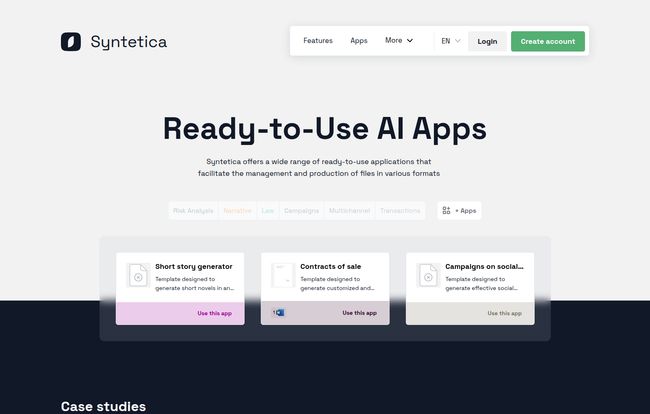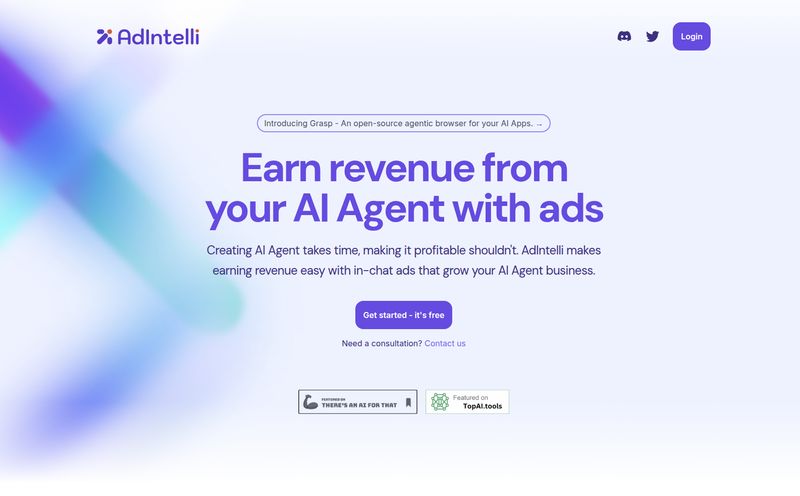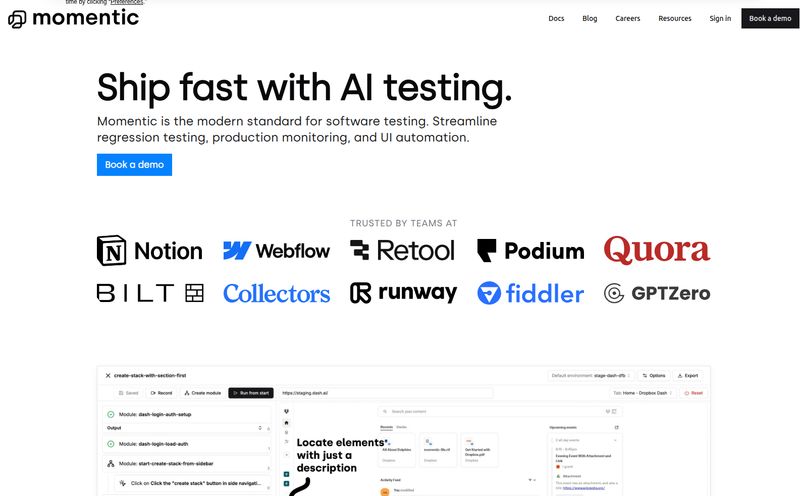If I see one more “revolutionary AI content generator” pop up in my feed, I might just throw my laptop out the window. We're drowning in them. They all promise to write your blogs, your emails, your entire novel... and most of them churn out generic, soulless fluff that needs more editing than it would’ve taken to just write the damn thing yourself.
So when Syntetica crossed my desk, my skepticism was, shall we say, at an all-time high. Another one? But then I looked a little closer. The messaging wasn’t just about “writing content.” It was about generating documents, creating processes, and sharing them with a team. That... that felt different. It sounded less like a simple AI writer and more like an AI-powered engine for your entire content workflow. Okay, Syntetica. You have my attention.
So, What is Syntetica, Really?
Forget the buzzwords for a second. In my own words, Syntetica is like building a set of custom-made AI-powered assembly lines for your documents. Instead of just asking an AI to “write a social media post,” you build a repeatable process. For instance: a process that takes a product name, a key feature, and a target audience, and then generates five different ad variations, a short-form video script, and a customer support email template. All in one go. You build the machine once, then you just feed it the inputs and let it run.
It’s designed to handle complexity. We’re talking contracts, detailed reports, onboarding materials, and campaign briefs—the kind of stuff that has a consistent structure but needs unique details every time. This isn’t just about avoiding writer's block; it's about systemizing the grunt work out of existence.
The Features That Actually Matter
A features list can be boring, I know. But some of these are worth talking about because they're the nuts and bolts of what makes this platform interesting.
No-Code, No Problem
This is the big one for me. I can hold my own with some basic code, but I'm an SEO and a writer, not a developer. The idea of building these complex “processes” without needing to write a single line of Python is hugely appealing. Syntetica has a visual, intuitive interface where you can drag, drop, and connect different steps to build your workflow. This opens it up to marketing managers, HR professionals, legal assistants—basically, anyone who understands the process but doesn’t speak code.
Your Personal Content Assembly Line
This is what they call “Custom Processes.” It's the core of the whole thing. You can design a flow from scratch, specifying exactly what kind of inputs you need and what kind of outputs the AI should generate. It allows you to embed your own expertise and best practices directly into the tool. Once it's built, any member of your team can run it. No more explaining the same content brief over and over again. Just point them to the Syntetica process and say, “Go.”

Visit Syntetica
Playing Nice with Your Existing Tools
A new tool is useless if it lives on an island. Syntetica seems to get this. The integration logos on their site are promising—Google, Slack, Notion, the usual suspects. This means you can create workflows that, for example, pull data from a Google Sheet, use it to generate a report in Syntetica, and then ping you on Slack when it's done. That’s how real work gets done, by connecting the apps we already use. They claim over 40 integrations, which is a solid start for creating a truly automated suite.
Let's Talk Money: The Syntetica Pricing Breakdown
Alright, the all-important question: what’s it going to cost? The pricing structure is a mix of a monthly subscription and a token-based system, which can be a bit to get your head around, so let's break it down. Think of tokens as the fuel for the AI; every time you generate something, you use up some tokens.
| Plan | Price | Included Tokens | My Two Cents |
|---|---|---|---|
| Free | $0 / month | None (Pay-as-you-go) | Perfectly generous for a test drive. You get to try the core features for up to 2 users without commitment. You just pay for the tokens you use. |
| Starter | $9.95 / month | 100,000 / month | This is the sweet spot for individuals or very small teams. It gives you a good chunk of tokens and more storage. A no-brainer to start with. |
| Business | $49.90 / month | 1,000,000 / month | For teams who are making Syntetica a core part of their professional workflow. The token count is substantial, and the cost per extra token drops. |
| Enterprise | $299.90 / month | 5,000,000 / month | For larger organizations looking to go all-in. More users, massive token allowance, and the cheapest rate for additional tokens. |
The token system is something to watch. While it's great that you can exceed your monthly allowance, you'll need to monitor your usage so you don't get a surprise bill. It's a fair system, but it requires a bit of management. It’s also nice that they have a Custom plan option, which suggests they're willing to work with unique needs.
The Good, The Bad, and The... Complicated
What I Genuinely Liked
The biggest pro is the shift in mindset it encourages. You stop thinking about one-off tasks and start thinking about building systems. That’s a real productivity game-changer. The ability to create a custom process, fine-tune it, and then hand it off to a junior team member is incredibly powerful. It standardizes quality and saves a ton of time. And the no-code builder is genuinely easy to get the hang of. It felt less like programming and more like drawing a flowchart.
A Few Things to Keep in Mind
It’s not all perfect, of course. For one, dedicated support is reserved for custom plans. For everyone else, you’re likely relying on community forums (they have a Discord) or standard ticket support. Not a dealbreaker, but something to be aware of. The token-based pricing, as mentioned, requires you to be mindful of your usage. If your team goes wild one month, you'll feel it. There's also the inevitable risk of platform dependency. If you build your entire content operation around Syntetica's processes, you're pretty tied to them. That's true of any core business software, from Salesforce to HubSpot, but it's worth considering.
So Who is Syntetica Actually For?
This isn't for the person who wants to type “write me a blog post about dogs” and get a finished article. This is for people with recurring, structured content needs.
- Marketing Teams: Imagine building processes for ad copy variations, social media calendars, SEO meta descriptions, and product descriptions. It's a dream for scaling content creation.
- HR and Legal Departments: Think about automating the creation of offer letters, employment contracts, and internal policy announcements. It ensures consistency and reduces manual errors.
- Agencies and Freelancers: Create a unique process for each client's needs—from weekly reporting to content briefs—and execute it flawlessly every single time. It's a way to scale your services without scaling your headcount.
If your work involves creating the same type of document over and over, with only minor changes? Syntetica might just be your new best friend.
Frequently Asked Questions
Is Syntetica hard to learn?
Based on its no-code, visual builder, the learning curve seems pretty gentle. If you can map out a process on a whiteboard, you can probably build it in Syntetica. The challenge isn't the tool, it's clearly defining your process first.
What exactly does the free trial include?
The 'Free' plan isn't a timed trial, it's a permanent free tier. It gives you access to the platform for up to 2 users with 500 MB of storage. You don't get any included tokens, so you pay for what you generate on a per-token basis. It's great for trying before you buy a subscription.
How does the whole token thing work?
Think of it like a word count for the AI. Every piece of text the AI processes or generates consumes tokens. A simple task might use a few hundred, a complex document could use thousands. Your subscription gives you a monthly budget of tokens, and you can buy more if you run out.
Can I cancel my subscription anytime?
Yes, the FAQ on their site confirms you can cancel subscriptions. It's always good practice to check the specific terms, but this is standard for modern SaaS platforms.
Can I integrate Syntetica with my other tools?
Yes, integration is a key feature. They support connections with popular tools like Google Drive, Slack, and Notion, allowing you to build workflows that span across different applications.
My Final Verdict on Syntetica
So, is Syntetica worth the hype? I came in skeptical, but I'm leaving... impressed. It's not just another AI writer in a sea of clones. It’s a thoughtful, process-oriented platform that aims to solve a much more interesting problem: not just what to write, but how the writing gets done, repeatedly and at scale.
If you're a solopreneur or part of a team that feels like you're constantly reinventing the wheel for routine documents, you owe it to yourself to give Syntetica a look. Start with the free plan, try to automate one—just one—of your most annoying, repetitive tasks. You might be surprised at how much you like building your own little content factory. I know I was.



